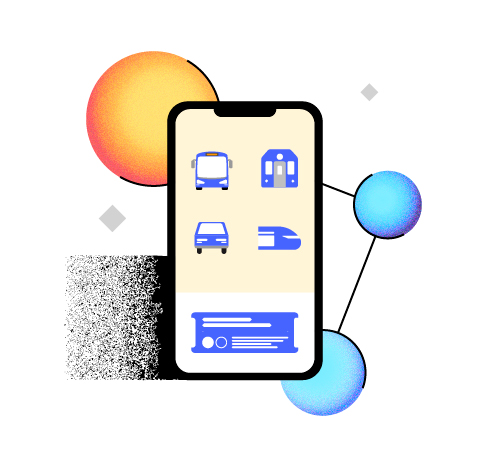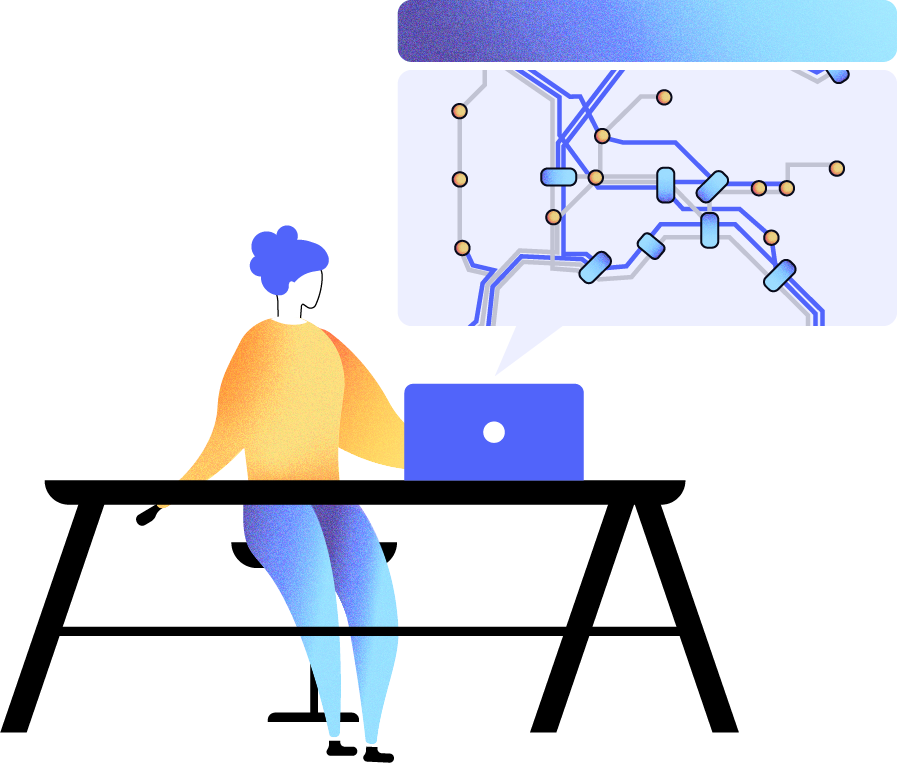Sectors are disrupted, new markets appear, while others converge or disappear. Mobility is undergoing one of its most important social, technological and economic changes. This transformation is fueled by three major disruptive technological trends. Electric vehicles, autonomous vehicles and mobility as a service (MaaS). Separately, each of these advances would significantly disrupt the ecosystem, but by combining them, they have the potential to totally reinvent mobility. In many markets, we are seeing a clear shift in the way consumers perceive mobility. In particular, with regard to vehicle ownership. These changes can be attributed to the willingness of consumers to have “on-demand” mobility as an alternative to ownership.
At the same time, societies are also undergoing major transformations. By 2050, there will be 9 billion of us on the planet and 70% of us will live in cities. As a result, it is becoming essential for cities to have intelligent mobility solutions. It is in this context that service mobility comes into play. MaaS includes the multimodal aggregation of transportation modes as well as mobility on demand. In this sense, mobility as a service is the next step in the evolution of transportation. These new forms of travel can bring many benefits to both transit authorities and consumers. Promoting sustainable mobility, reducing pollution and improving the passenger experience. Let’s find out how MaaS will revolutionize tomorrow’s mobility.
MaaS, a catalyst for tomorrow’s mobility
What is MaaS ?
Bus, tramway, metro, parking relay, train, self-service bicycle, scooter, VTC, rental car… Today, we have a real panoply of mobility services. Not always easy to find one’s way around, Maas (Mobility as a service) is today a real revolution. By grouping the entire range of transportation services on a single platform, the passenger experience is greatly improved. Users will be able to plan, book and pay for all these means of transport.
MaaS works in part thanks to complex infrastructure and cooperation between the public and private sectors. Open data is therefore emerging as a means of promoting innovation in the sector. With access to this multitude of information, each mobility stakeholder is able to create value.

An innovative approach
Beyond the technical aspect, MaaS highlights a new approach based on interoperability and intermodality. According to Baromètre des Mobilités du quotidien – 2019 edition, 64% of French people are used to using a single mode of transportation for the majority of their trips. Among them, 82% use only the car. With 1 in 2 people feeling uninformed about the mobility services available to them, it is important to rethink and simplify access to mobility. Mobility as a Service thus represents an interesting opportunity.
According to the “Observatory of Emerging Mobilities 3“, MaaS solutions are favored by 59% of Europeans. Concerning their functionalities, 44% are mainly interested in the simplicity of access to means of transport. 35% by the fact that they will be able to reduce their use of cars. Finally, 19% are particularly interested in the fact that they will no longer have to buy. tickets.
A growing market

According to Orbis Research, the MaaS market was valued at $24.1 billion in 2017. By 2025, the market is expected to reach $230.40 billion. BIS Research has also published a study on the subject. According to its report, the global market for mobility as a service will be estimated at $1.75 trillion by 2028.
The main drivers of this industry are, among others, transportation-on-demand services and government. Government policies and public sector involvement play a very important role in the growth of this industry.
Improve the travel experience
MaaS has the potential to change the way we travel. Residents of a city with fully integrated MaaS platforms are able to use relevant modes of transportation, at the right time, at the best price, and with ease.
Enhanced travel comfort
These new solutions can result in an increased comfort and sense of security for passengers. Consumers have the ability to filter transportation options. Thus, they can choose their trips based on availability, passenger density, price or transportation schedules. The advantage for travelers is therefore that they can travel according to their preferences. Passenger information is also enhanced.
By quickly accessing the information they are looking for, MaaS application users will also save time. Via a single platform, they have the ability to go anywhere in the world. As a result, there are no more geographical constraints or language barriers.
Payment made easy
Mobility as a service promotes simplified payment methods. In contrast to the separate booking of different modes of transportation, here it is possible to make a single payment for the entire trip. For example, a consumer whose optimal itinerary includes a cab, train and scooter will pay only once for his or her trip. In addition, it is also possible for users to validate their tickets directly from the MaaS platforms.
Furthermore, MaaS enables secure payments. Thanks to the different payment methods taken into account by the platforms, users can pay for their trips without having to carry cash.
Helping Cities Meet Future Mobility Challenges
Mobility within cities will undergo major structural changes over the next few years. Nearly one in three European city will see its population increase by more than 10% over the next 30 years. In recent decades, passenger transportation has been dominated by private car. The massive adoption of this means of transport has led to congestion and negative environmental impacts. On the one hand, this has resulted in an increase in travel time. And on the other hand, an increase in air and noise pollution. Many cities are beginning to address these issues. To do so, they are implementing different strategies. MaaS offers more than just convenience. Indeed, smart cities cannot be considered or designed without taking into account MaaS solutions.
MaaS promotes three fundamental urban objectives: economic growth, respect for the environment and society.
A world without traffic jams
According to a study conducted by the AECA (European Automobile Manufacturers Association), European motorists spend an average of 18 hours in traffic jams. The world average is 50 hours per year. Another alarming finding is that more than one million people lose their lives in car accidents every year. Between 20 and 50 million are victims of road trauma. It is interesting to note that cars account for 85% of our spending on mobility while they represent only 29% of our trips on average.
MaaS can help municipalities by reducing the number of vehicles in service. Rather than making each individual depend on a personal vehicle, the approach to these new forms of mobility is to use public and shared transportation services. This reduces traffic congestion and pollution. As a result, communities will be able to reclaim space previously devoted to parking lots or roads.

Greener cities
Automobiles are a major source of pollution, responsible for 7 million premature deaths worldwide. The European Environment Agency estimates that road transport contributes to excessive pollution. It is estimated that about 7% of the urban population in the European Union is exposed to nitrogen oxide (NO2) levels above the limit value prescribed by the WHO (World Health Organization). In addition, three quarters of the urban population is estimated to be exposed to levels of particulate matter (PM) exceeding the WHO guideline value.
By encouraging people to use shared means of transportation or to carpool, MaaS limits the number of car trips and thus pollution. According to a study conducted by Volkswagen, by adopting a policy that promotes sustainable mobility, in just 10 years it would be possible to reduce pollution by 48% and car congestion by 68% in a city of 5 million inhabitants.
MaaS and COVID-19
Changes in working methods and transportation needs have emerged from the coronavirus crisis. There is a public willingness to share data to ensure the safety and reliability of transportation systems. There is also an increased enthusiasm for “micro-mobility“, such as electric bicycles and scooters. As a result, the pandemic has had a positive impact on the use of MaaS, constituting a growth driver for the latter.
Transportation and social distancing
In this context, the global pandemic of 2020 has marked a radical change in behavior and has altered many of our priorities. Many companies have adopted home-based work. Even during reopenings, we have seen a strong impact on public transportation. In a short period of time, public transportation use dropped by 80 to 90% in all major cities. Shared mobility modes have become less attractive. As a result, people are looking more for alternatives that combine efficiency and safety.
Today more than ever, micromobility is proving to be a preferable option. Electric scooters and bicycles are particularly interesting for short distances. Indeed, they allow citizens to avoid not only road congestion but also overloaded public transport. Local authorities have reacted quickly, increasing the availability of bicycle paths and making some parts inaccessible by car.
Data sharing
Today, data sharing is essential in the deployment of a successful mobility strategy. It is proving to be the most secure and effective option in the post-Covid context. Employees and companies could, for example, evaluate in real time whether it makes sense to go to the office or to work remotely. This would allow transport operators to adapt more easily to unforeseen changes.

In addition, the integration and aggregation of all transportation-related information will give cities unprecedented insight into travel patterns. With the help of Artificial Intelligence (AI) and Machine Learning (ML), they will be able to analyze and draw conclusions. Conclusions about how people move and what influences them. In this way, municipalities could propose alternatives when a specific itinerary is not available. As mobility services multiply, shared and public transportation modes will become increasingly convenient and efficient. The MaaS will play a major role in these developments.



